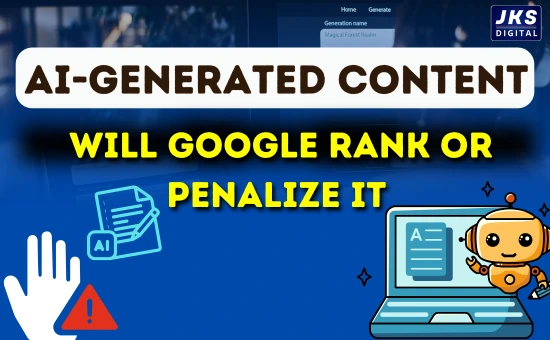Artificial Intelligence (AI) has completely changed the way content is created. From blog writing to SEO optimization, AI tools like ChatGPT, Jasper, Copy.ai, and others have given marketers and creators the ability to produce content quickly and effectively.

But this feature also brings a big question: Will Google adopt AI-generated content or rank it on SERP?
If you are a digital marketer, blogger, SEO expert, or business owner creating content using AI, this article is extremely important for you. In this article, we will analyze this question in full depth, including Google’s official view, SEO best practices, risks, and tips for making AI content human-friendly and rank-worthy.
What is AI-Generated Content?
AI-generated content is content—of whatever type—that is created with the help of artificial intelligence algorithms rather than written solely by humans. This includes:
- Blog articles
- Social media captions
- Product descriptions
- Emails
- Ad copy
- FAQs and more
These tools analyze data, mimic writing styles, meaning if someone has already written an article on a topic and we post an article on the same a month later, the AI will give us duplicate content, and create content in a matter of seconds. However, not all AI-generated content is the same—some are high-quality and informative, while some may be superficial or repetitive.
Google’s official view on AI-generated content
Google updated and clarified its Search Central Guidelines in 2023:
“Use of automation—including AI. If AI is used just for ranking or to menuplate Google will consider it spam. However, not all AI-generated content is considered spam. Google focuses on quality, not how and who created the content
In short, Google doesn’t care whether the content is written by humans or AI — as long as it’s useful, original, and trustworthy.
How does Google rank AI-generated content?
Google has complex algorithms and ranking systems such as:
- Helpful Content System
- E-E-A-T (Experience, Expertise, Authoritativeness, Trustworthiness)
- SpamBrain AI
These systems analyse whether the content:
- Does it clearly answer the user’s query
- Is it backed by facts or experience
- Does it reflect knowledge and authority
- Is it free from spam and duplication
If your AI-generated content meets these criteria, it can rank on Google.
AI content that ranks well:
- Written with a clear structure (H1, H2, bullet points, etc.)
- Provides unique insights, not just definitions or general information
- Matches the user’s search intent
- Edited and reviewed by humans
- Combines human expertise with AI-generated text
When can AI-generated content be penalized?
- Google has advanced techniques to identify low-quality or manipulative AI content, especially if it:
- The content is organized with H1, H2 tags, and bullet points, making it easier to read.
- The content contains new and in-depth information that goes beyond the usual information.
- The content accurately serves the user’s search intent.
- AI content is edited and improved by humans.
This type of content may be flagged by Google’s SpamBrain system and may lead to manual action, poor rankings, or complete de-indexing.
Why does human touch matter?
AI can mimic human writing styles, but it lacks emotion, context, real experiences, and the art of storytelling. This is why Google’s algorithms still prioritize content that humans edit and provide value.
Ways to Add a Human Touch:
- Personal anecdotes or case studies
- Cultural or local relevance
- Expert quotes or references
- Unique opinions and analysis
- Emotional elements that AI can’t understand
Tip: Use AI as an assistant, not a replacement.
Best Practices for Creating Google-Friendly AI Content
If you want your AI-generated content to rank well, follow these golden rules:
1. Combine AI + human expertise
Let AI help you write drafts, outlines, or headlines — but add your own voice, real examples, and research.
2. Use reliable SEO tools
Always validate your AI content with these tools:
- Grammarly (for grammar and tone)
- SurferSEO or Frase (for SEO optimization)
- Originality.ai (for AI percentage detection)
- Ahrefs or SEMrush (for keyword research)

3. Avoid over-automation
Don’t auto-generate 100 blogs daily. Instead, prioritize specialty.
4. Check all the facts
AI sometimes generates “hallucinated facts” — double-check names, statistics, and sources.
5. Ensure originality
Use plagiarism checkers like Copyscape or Quetext to ensure your content is unique.
Case studies on AI content: Do AI articles really rank?
Case 1: Travel blog using ChatGPT + human editing
A travel blog writer used ChatGPT to draft a travel guide and added local stories, tips, and SEO headings. Result: 20% increase in organic traffic in 2 months.
Case 2: E-commerce store scraped product details from AI
An online store used AI to create 1,000+ product descriptions without editing them. Result: massive drop in rankings and multiple warnings on Google Search Console.
Read Also:- Adani Success Story: How to Make Your Business No.1 with Digital Marketing
The Future of AI Content in SEO: What to Expect?
Google’s algorithms are evolving, and so is AI. We expect that:
- Tools to better detect AI (Google Gemini, AI classifiers)
- More emphasis on E-E-A-T content
- AI-assisted SEO, not AI-replaced SEO
- Need for transparency: Google might prefer content that has clear authorship and editorial process
Read Also:- ChatGPT Ads: A New Era of Free User Monetization Coming in 2026?
Conclusion
Yes, Google will rank AI-generated content but that content should not be duplicated and should be useful and informative – if it is valuable, original, correct and human-reviewed, then this article will definitely rank on Google.
It will not rank content that is spammy, copied, or simply designed to cheat in the rankings.
To find success with AI content in 2024 and beyond
- Use AI as an assistant, not a replacement
- Combine the efficiency of AI with human creativity
- Prioritize user intent, clarity, and reliability
- Edit, check, and optimize before publishing

